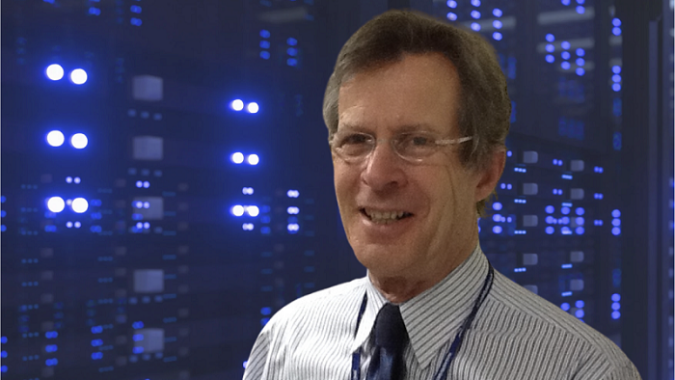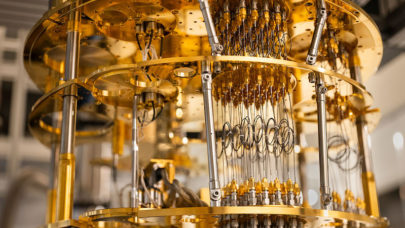Veteran HPC analyst Steve Conway has joined the Intersect360 Research team, effective this week. As Senior Analyst, Conway will conduct HPC market research with a special focus on AI, edge and composable computing, while keeping close tabs on the international technology stage. In an interview with HPCwire, Conway said one of the things he was most looking forward to was working with Intersect360 Research CEO Addison Snell and Chief Research Officer Dan Olds. It will be a reunion of sorts for the trio, whose paths have crossed previously – at SGI and IDC (for Conway and Snell) and at Cray (for Conway and Olds). A 30-year industry professional, Conway was most recently head of Conway Communications, providing HPC and AI industry analyst services to clients, and prior to that he worked for IDC and spinoff Hyperion Research. Conway is a former Senior Fulbright Fellow (Germany), and has held affiliations with Boston University and Harvard University.
Tiffany Trader: Can you share about your background and how you got into computing, HPC and analyst work. I think we share a linguistics background.
Steve Conway: I know you and I share a strong interest in language. For me, language is the oldest and strongest indicator of how our brains deal with the world. As German philosopher Ernst Cassirer once said, language and science are abbreviations of reality.
My degrees are in literature, but I minored in physics and always had a strong interest in science and technology. My first job was as a sysop for an IBM 360 at an insurance company. Later, I headed investor relations and corporate communications at Cray Research, then I ran my own consulting firm where IDC was a major client and that led to full-time analyst jobs at IDC and spinoff Hyperion Research.
Trader: How did the opportunity with Intersect 360 Research come about?
Conway: I had a great time working with Earl Joseph and the team at Hyperion Research, and I think I did the best work of my career there in recent years, including authoring reports for EuroHPC and co-authoring with Johns Hopkins APL staff an AI primer for senior U.S. military leaders and a position paper on edge computing for the U.S. Congress. I could see, though, that my strong interest in trends such as AI methodologies, edge computing, composable architectures and the dynamics of the European HPC market might need a new home. So, I reluctantly left Hyperion and began accepting assignments on my own again. That’s when Addison Snell and I reconnected and began talking about whether my interests would be a better fit at Intersect360.
Trader: And you and Addison Snell used to work at IDC together?
Conway: Addison and I were colleagues at SGI, after SGI bought Cray Research in 1996, and then again at IDC, where we worked closely together. Dan Olds and I were colleagues when I worked at Cray headquarters in Minnesota and Dan worked for the Cray Business Systems Division in Portland, Oregon. I spent a lot of time in Portland as a liaison to this new division, and on the road with my good friend Shahin Khan and others to introduce the Cray CS6400, which later became the Sun E10000 system, to commercial firms.
Trader: As Senior Analyst, what will be your primary focus, roles and responsibilities?
Conway: Intersect360 is a small enough company that we all need to be chief cooks and bottle washers who handle a wide range of tasks and assignments, so we’re all well-rounded. The special strengths I want to contribute are in AI, cloud and edge computing, composable architectures, HPC in SMBs and other commercial firms, European market dynamics, indigenous technology initiatives and sustainability.
Trader: What are you most looking forward to?
Conway: Working again with Addison and Dan, along with Amy Snell, and helping with the exciting mix of studies and other work Intersect360 Research has committed to do for the company’s roster of clients in the Americas, Europe and the Asia-Pacific region.
Trader: In recent Q&As with HPCwire, you’ve shed light on important, trending topics, such as HPC sovereignty and edge computing. Can you provide a synopsis and update on where HPC sovereignty stands?
Conway: Indigenous technology movements aimed at establishing or maintaining HPC sovereignty are advancing around the world, including the U.S., and the context for each is different. They’re all driven in part by the growing recognition by governments of HPC’s important role in advancing economic competitiveness as well as science and engineering. The push for processor independence, at a minimum uninterrupted access to processors, plays a central role in all of the initiatives. That may mean replicating TSMC and Samsung facilities in the U.S., or advancing SiPearl and any other European Processor Initiative startups, or ramping up Chinese processor developments in the face of trade limitations, or moving forward with ARM64 and RISC-V customizable processors at Fujitsu and other firms around the world.
Longer-term questions raised by these initiatives include the possibility that they may split today’s global HPC market into regional markets with strong protective barriers for non-native vendors. Barriers already exist in the U.S., Japan and China, but barriers could become higher if each of these regions and Europe all had strong HPC technology to protect. How many HPC system vendors and how much innovation funding could each of these regional markets sustain? I don’t think things will go this far, but it’s a risk. Fortunately, so far global research collaboration hasn’t seemed to suffer from the indigenous tech initiatives.
Trader: And big picture, how do you view the intersection of edge computing and HPC? Are there use cases you find particularly notable?
Conway: There’s a tendency to see edge computing as an outward extension of what happens in datacenters and clouds. But it’s important to view things from the perspective of the edge, where most of the data may never need more powerful resources in datacenters and clouds.
From this perspective, HPC has a crucial role to play in the subset of edge computing applications that need wide-area analysis and control, as opposed to just local responsiveness.
Many existing HPC-supported science and engineering applications will benefit from increasing use of edge data. On the commercial and dual-use sides, besides urban traffic management and related automated driving systems, other prominent edge use cases for HPC include precision medicine, fraud and anomaly detection, business intelligence and smart cities development.
Trader: What other topics and trends are grabbing your interest or do you find concerning? What about security?
Conway: Security concerns are increasing. Several supercomputers in European HPC centers were temporarily hacked not long ago, for example. Another important topic, especially with high energy prices, is sustainability. A decade ago, experts predicted that exascale supercomputers built with then-current technology would consume 120 megawatts of electricity at an annual cost of well over $100 million. Today’s exascale systems might have been unfundable if increased energy-efficiency hadn’t dropped annual costs into the 20-30 megawatt range. It’s not just the costs; supercomputers and large data centers can also have a negative impact on the environment.
My biggest interest, accompanied by some concerns, is in the evolution of AI methodologies and progress toward the aspirational goal of artificial general intelligence. I wonder, for example, if and when computers and other AI devices will be equipped with sophisticated sensors that allow them to gather their own problem-solving data in real-time, as we humans do, obviating the need for massive training based on sample data that may be only partially related to the problem at hand. Concerns are that AI may still be in a hype period and momentum could sometimes overwhelm ethical considerations.
Trader: What do you make of the international exascale playing field?
Conway: All of the major players – the U.S., Japan, Europe and China – are likely to emerge as leaders in the early exascale era. Each has targeted its own set of applications for exascale; and performance on these complete, 64-bit applications is more important than who crosses the finish line when, or who tops the Top500 list. The European Union’s progress in organizing the member states and revising funding mechanisms has been especially impressive to me, and China, as we know, may have deployed the first exascale systems without submitting Linpack results. Exascale technologies are going to move downward over time, not just to entry-level HPC systems but very likely also to enterprise computers and even personal technology. It surprises me that many government agencies seeking exascale funding haven’t used this extended ROI argument to their advantage.
Trader: Anything you wish to promote? Upcoming events?
Conway: Dan Olds heads our student cluster competition program, whose next event will be the third annual Winter Classic Invitational. The 2022 Winter Classic will be hosting teams of students from Historically Black Colleges and Universities and Hispanic Serving Institutions in the U.S. We’re looking for organizations that want to be sponsors or HPC mentors. To learn more or get involved, contact [email protected] or go to www.winterclassicinvitational.com.





























































